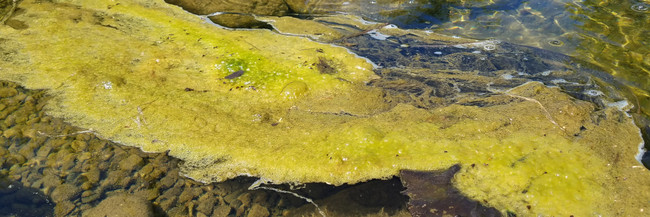Treating Different Types Of Pond Algae
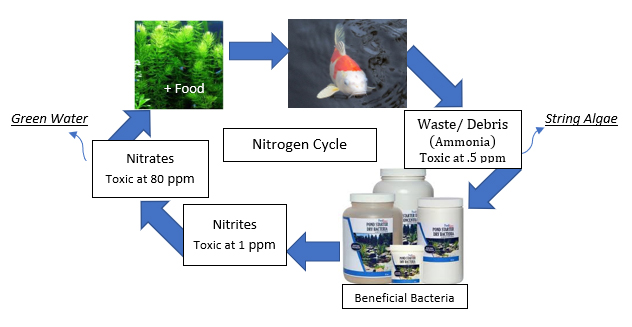 It’s true,
algae can be very unsightly and sometimes disheartening, but it’s also true
that some algae is actually good for your pond and water garden.
It’s true,
algae can be very unsightly and sometimes disheartening, but it’s also true
that some algae is actually good for your pond and water garden.
The following content will help you identify different types of green algae found in your water garden and how to keep it under control.
I learned in high school biology that algae are of the simplest plant organisms and that wherever you find sunlight, nutrients and water…. it will grow.
“In any pond, to reduce or eliminate algae, the real solution is to control and reduce the nutrients going into the pond – fish food, nutrient run off such as mulch and remove the nutrients that does go into your pond by using plants, bacteria, skimmer and nets.”
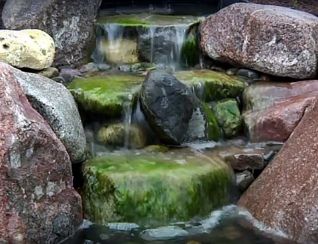
Filamentous Algae (often called String or Hair Algae)
- This is the long stringy green stuff you see flowing down the waterfall or along the edges of the pond.
- You will often see this early in the spring before the water temperatures are warm enough for beneficial bacteria to start working and before pond plants come out of dormancy.
- It
is normal to see string algae in the spring of the year. In fact, it is
actually helping to provide:
- protection for your fish from predators
- filtration for the water, consuming the toxic ammonia
- food for fish until temperatures get warm enough to start feeding them fish food
Once the plants come out of dormancy, however, you should see the string algae start to shrink away. Throughout the warm season, algae should appear on the surface of your pond’s rocks as a “peach fuzz” and your water should be crystal clear. That is how you know you have a balanced eco-system.
If the hair algae/string algae starts to become long and stringy again (more than an inch long) during the warmer weather, you may need to check a couple of things:
- Ask
yourself whether you remembered to put the Pond Starter Dry Bacteria and Sludge & Muck B-Gone in regularly.
- We recommend using these beneficial treatments at least once a month. Once a week is better, but remember to only use a quarter dose if treating weekly.
- Excess string/hair algae feeds off of ammonia that comes from fish waste.
- When good bacteria is not present to break down the ammonia into nutrients for pond plants to absorb, you will see more algae in your pond.
- Are
you overfeeding your fish or is the pond over populated?
- The more and the bigger your pond fish are, the more fish food that will be used and the more waste that will be excreted into the pond.
- Test the pH of your pond water. If the reading is 8.6 or higher, then the beneficial
bacteria will not work properly. Another sign of this is that
your water hyacinth and water lettuce will stay small and begin turning brown.
In this instance, you may need to:
- Make
sure your biological filter is not overloaded with muck.
- Once you start adding Nitrifying Bacteria Plus treatment for the season, DO NOT rinse your biological filter media with the garden hose. The temperature difference and/or chlorine will kill the good bacteria that is already growing and you will have to start all over. Instead, rinse your filter media with pond water. This removes the excess muck but keeps some of that beneficial bacteria intact.
- Remove excess muck or debris from the bottom of the pond with a Pond Vacuum. As water temperatures get warmer decomposition speeds up and uses more oxygen in the process. String/Hair Algae also grows on this muck and will break loose and float to the surface.
- Make
sure your biological filter is not overloaded with muck.
- Physically
remove algae from your pond by hand (or with tools like an algae twister or pond shark net) before using any kind of pond algae water
treatment.
- If you do not, the dying algae will stay in the pond - adding to the waste that uses more oxygen and feed future algae. You can also use a clean, unused toilet bowl brush.
- Using pond algae treatments incorrectly can kill your pond fish. An overdose, not enough circulation or not enough oxygen in the water, caused by dead algae, can kill your fish. As I said above, oxygen can be depleted and more debris is left in the water to feed the algae to come.
- We
encourage you to use natural pond water treatments to treat the cause, when
time will allow.
- Add crushed oyster shells, in a fine mesh bag, to your waterfall box to help stabilize pH.
- Do a partial water change as you clean the muck from the bottom with a Pond Vacuum.
- Use water lilies and marginals to help control water temperature and filter the water...or possibly a bog garden filter.
- Submerged aquatics (seaweed) are extremely important.
- Adding barley straw or, better yet, barley straw extracts (all the benefits, none of the mess) will help prevent future algae growth in your pond water.
- Be sure to keep your skimmer filters clean. Cleaning your skimmer filters will remove suspended waste from the water. It’s like vacuuming your carpets, the more often you do it, the cleaner it will be. We recommend doing so at least once a week.
- Continue adding your beneficial bacteria regularly.
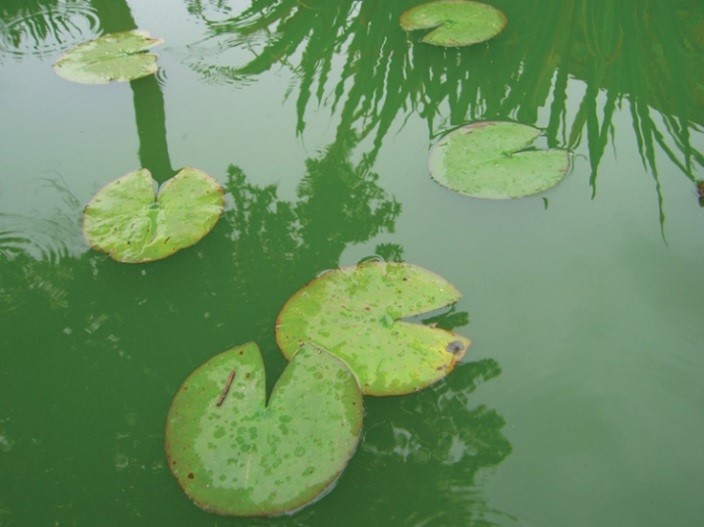
Green Water Algae
- Some people may refer to it as “pea soup” or an “algae bloom.” It is a microscopical green algae that is suspended in the water. As this single cell algae multiplies, it starts to clump together making your water appear cloudy. As the number of algae increases, water will look more green until your it becomes as dark green as pea soup.
- Green water is not necessarily a sign of an unhealthy pond. In fact, overreacting can cause more harm than good. You just need to get things back in balance.
- Green
water is most commonly caused by excess nutrients in the water.
- Nutrients come from decomposing debris and fish waste that the beneficial bacteria have broken down.
- Nutrients may also be from soil, mulch and lawn fertilizer run off from around the pond.
- Nitrates are the final stage in the nitrogen cycle.
- The best treatment is plants, plants and more plants! Did I stress that enough? As I said earlier, beneficial bacteria breaks down decomposing debris and fish waste. These nutrients are then taken up by marginals, bog plants, floating plants and seaweed (submerged aquatics). Plants should be at all levels of your pond to help take nutrients out of the water.
- Water
treatments to help clarify pond water, known as flocculants, like Pond Basics Pond Clarifier, may be used in a pinch to help clear up dirty pond water.
These products take suspended particles and clump them together so they become
heavy and settle to the bottom of your pond.
- Just be warned, more is not better in this situation. Too much can cause an adverse reaction making the water cloudier.
- Pond aeration will help lift clumped particles and hopefully send them out through the skimmer filter as your pond pump draws the water.
- Natural pond water treatments include:
- A partial water change can help dilute the concentration of green algae - but that’s only a start. If balance is not restored, algae will continue to grow and cloud the pond water up all over again.
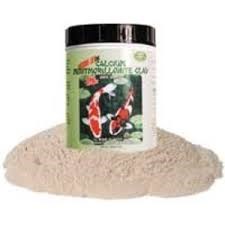 A
natural product called Calcium Montmorillonite Clay (CMC), made by Microbe-Lift,
works just like a chemical flocculant mentioned above. The beauty of it is, you
cannot overdose. Not only does this product “polish” the water, but it adds
special micro nutrients for fish and enhances their colors.
A
natural product called Calcium Montmorillonite Clay (CMC), made by Microbe-Lift,
works just like a chemical flocculant mentioned above. The beauty of it is, you
cannot overdose. Not only does this product “polish” the water, but it adds
special micro nutrients for fish and enhances their colors.- UV
lights are also effective against green water. As water passes through the
plumbing, the light will “burst” the cell wall of the algae organism, killing
it. It is important to have a UV properly sized for your water flow.
- However, keep in mind that this just treats the symptoms and does not cure the problem - which is having excess nutrients in the pond.
- It is important to know that a UV light does not differentiate between algae and bacteria, so be sure you turn off your UV light for a couple days after adding your beneficial bacteria.
In Summary:
- Don’t overreact and over treat an algae situation.
- Chemicals only treat the symptoms, while natural treatments fix the problem.
- Using natural water treatments, pond filtration and pond plants will keep your water in balance long term.
